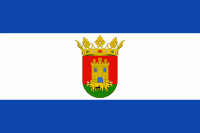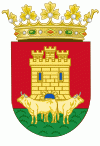Talavera de la Reina (Talavera de la Reina)
 |
 |
Although the city straddles both banks of the Tagus, few kilometres downstream from the junction of the former with the Alberche, most of the urbanisation concentrates on the right (northern) bank. There are two islands in the center of the city called Isla Grande and Chamelo Island. Three bridges cross the Tagus in Talavera.
The city is well known by its pottery craft. The Talavera de la Reina pottery was declared intangible cultural heritage by the UNESCO in 2019.
There are remnants of prehistoric cultures in the area. The village was founded by the Celts as a ford of the Tagus. The first mention of the city (with the name Aebura) occurs in Livy's description of a battle between the Romans and the Carpetanoi, a Celtiberian tribe. After the Roman conquest of Hispania, it was known as Caesarobriga, one of many Celtic toponyms preserved in Roman Hispania, with a name connoting "fortified" that was extended to many non-fortified towns: "Caesarburg". Caesarobriga served as an important center for agriculture and ceramics in the 3rd and 4th centuries BCE During the Visigothic period, Talavera reverted to a variant of its Celtiberian name: Elbora or Ebora. Its modern name is derived from Talabayra, the Muslim rendering of this Visigothic name. The city was conquered by Muslim forces in 713 and conquered by Christian forces under Alfonso VI of Castile in 1083.
Map - Talavera de la Reina (Talavera de la Reina)
Map
Country - Spain
 |
 |
| Flag of Spain | |
Anatomically modern humans first arrived in the Iberian Peninsula around 42,000 years ago. The ancient Iberian and Celtic tribes, along with other pre-Roman peoples, dwelled the territory maintaining contacts with foreign Mediterranean cultures. The Roman conquest and colonization of the peninsula (Hispania) ensued, bringing the Romanization of the population. Receding of Western Roman imperial authority ushered in the migration of different non-Roman peoples from Central and Northern Europe with the Visigoths as the dominant power in the peninsula by the fifth century. In the early eighth century, most of the peninsula was conquered by the Umayyad Caliphate, and during early Islamic rule, Al-Andalus became a dominant peninsular power centered in Córdoba. Several Christian kingdoms emerged in Northern Iberia, chief among them León, Castile, Aragon, Portugal, and Navarre made an intermittent southward military expansion, known as Reconquista, repelling the Islamic rule in Iberia, which culminated with the Christian seizure of the Emirate of Granada in 1492. Jews and Muslims were forced to choose between conversion to Catholicism or expulsion, and eventually the converts were expelled through different royal decrees.
Currency / Language
| ISO | Currency | Symbol | Significant figures |
|---|---|---|---|
| EUR | Euro | € | 2 |
| ISO | Language |
|---|---|
| EU | Basque language |
| CA | Catalan language |
| GL | Galician language |
| OC | Occitan language |
| ES | Spanish language |
















